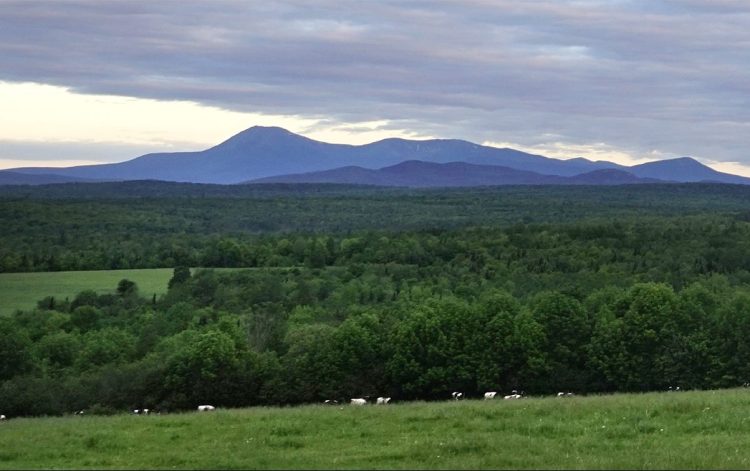Interior Secretary Ryan Zinke said Tuesday he did not recommend that President Trump alter the size or boundaries of Katahdin Woods and Waters National Monument, but said the land could be managed to promote a “healthy forest” and traditional recreation.
Zinke said commercial logging is not allowed within 87,500-acre Katahdin Woods and Waters, ending speculation that his recommendation of “active timber management” could mean commercial harvesting in the national monument. But Zinke left the door open for what he called “landscape improvements” and thinning of trees as part of a science-based forestry plan for the controversial national monument created by former President Barack Obama last year.
“We think in the case of Katahdin, a made-in-Maine solution works better and that’s promoting the healthy forest,” Zinke said.
The former Montana congressman, who visited the Katahdin region in June, also said the management plan being crafted with input from local communities should also include “hunting in some parts (and) opening up some roads for snowmobiling.” Both activities are currently allowed on parts, but not all, of the national monument located just east of Baxter State Park.
Zinke spoke with reporters one day after President Trump signed a proclamation to dramatically shrink Bears Ears National Monument and Grand Staircase-Escalante National Monument. Within hours of Trump’s announcement, at least 10 organizations, five Native American tribes and outdoor retailer Patagonia said they would challenge in court the president’s authority to change the national monument boundaries.
Katahdin Woods and Waters was among 27 national monuments reviewed by the Trump administration, reviving debate over a monument that supporters say is already paying dividends to the region. The interior secretary submitted that report to the president in August, but only publicly released the report on Tuesday, although leaked copies have been circulating since September. Trump has yet to act on the other recommendations in the report.
Zinke recommended revising the boundaries of four national monuments: Bears Ears and Grand Staircase-Escalante in Utah, Gold Butte in Nevada and Cascade-Siskiyou in Oregon. But Zinke said he also recommended other changes within 10 national monuments – including Katahdin Woods and Waters – “where the proclamations either did not fit the law or were inconsistent with the governor, the state legislature or the congressional delegation.”
In the case of Katahdin Woods and Waters, the report recommends changing the proclamation creating the monument “to ensure compliance with the provisions and intent of the (Antiquities) Act while also prioritizing (promotion of ) a healthy forest through active timber management.” As with other monuments included in the review, the report also recommends the Katahdin Woods and Waters management plan should “prioritize” public access, traditional uses, tribal cultural use, and hunting and fishing rights.
Zinke also recommended changing the proclamation creating Northeast Canyons and Seamounts Marine National Monument off the coast of southern New England to allow the regional fisheries regulators “to make fishery-management decisions” as authorized by federal law. The interior secretary did not discuss Northeast Canyons and Seamounts during his conference call with reporters.
Lucas St. Clair, who led the years-long campaign to designate a national monument in the Katahdin region on his family’s land, said he was still unsure how exactly the Interior Department was proposing to amend the proclamation. The Park Service can already manage timber for scenery, disease or to maintain infrastructure. On the issue of hunting and snowmobiling, St. Clair said expanding those activities throughout the 87,500-monument would “go directly against five years of collaboration with local groups” to strike a balance between allowing those activities in some areas while reserving other areas for “human-powered recreation.”
Overall, St. Clair said he feels confident in the structure of the monument created when his family’s nonprofit, Elliotsville Plantation Inc., donated the land to the federal government last year. St. Clair is the son of entrepreneur and conservationist Roxanne Quimby.
“Secretary Zinke has assured me over and over, both in person and over the phone, that the monument is going to stay as it is, which is a really good thing,” said St. Clair, who is running for Congress in Maine’s 2nd District as a Democrat. “There are good things happening on the ground and they are showing some signs of optimism. And many people in the region have related that optimism to the establishment of the monument.”
U.S. Rep. Bruce Poliquin, a Republican whose 2nd District includes the Katahdin region, had strongly opposed the monument designation.
“The recommendation put forward by Secretary Zinke is a smart compromise that will help ensure traditional uses of the land and sustainable forest management are safeguarded, along with the jobs they support in the area,” Poliquin said in a statement. “As I’ve said before, our goal should be to move this project forward in the right way to build a stronger economy that creates more and better paying jobs in the Katahdin Region and in Maine. Secretary Zinke’s recommendation strikes the right balance.”
Obama issued the proclamation creating Katahdin Woods and Waters in August 2016 on the eve of the National Park Service’s 100th anniversary. Quimby, who co-founded the successful Burt’s Bees personal care product line, had purchased land across the North Woods in hopes of eventually creating a national park in the region. But St. Clair shifted the focus toward a national monument – which can be created unilaterally by a president – after it was clear Maine’s congressional delegation was not unified behind a national park.
The designation followed years of heated debate over whether a national park or monument would help revive the Katahdin region or stymie industrial development and the forest products industry. Thousands of vehicles have visited the monument during its first year, despite the lack of amenities, unimproved roads and the fact that the LePage administration has refused to allow signs to be erected on public highways directing visitors to the land.
Opponents of the monument, most notably Republican Gov. Paul LePage, had been urging the Trump administration to scrap the designation altogether or allow the state to manage the land. LePage’s office did not reply to a request for comment Tuesday.
Organizations involved in the debate over Katahdin Woods and Waters were still trying to decipher the recommendations, particularly the report’s vague reference to “active timber management.” Interior Department staff did not respond to a request to clarify the meaning of the phrase.
“We will continue to promote and support the original intent of Katahdin Woods and Waters National Monument,” Andrew Bossie, executive director of the nonprofit Friends of Katahdin Woods and Waters, said in a statement. “We’re relieved that the report doesn’t recommend changes to the size or existence of the monument, but we will continue to monitor any efforts to amend the proclamation and monument as it currently stands.”
Kevin Miller can be contacted at 791-6312 or at:
Twitter: KevinMillerPPH
Send questions/comments to the editors.





Comments are no longer available on this story